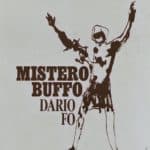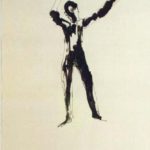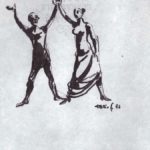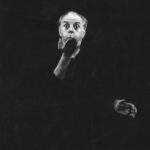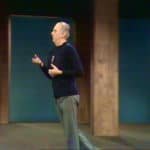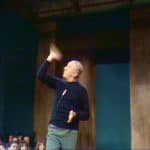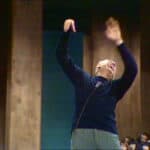Mistero buffo (1969)
monologue – “popular jestering” by and with Dario Fo
collaboration: Collettivo Teatrale Nuova Scena
Premiere, Sestri Levante (Genova), 1th October 1969
The Fabling of the Jester in Mistero Buffo: Dario Fo and the political re-use of popular material.
by Eva Marinai
After an open rehearsal at a students’ sit-in at the University of Milan, Dario Fo’s most celebrated play opened in Sestri Levante (Genoa) on 1st October 1969 under the guise of a “popular jestering”. The piece is a series of monologues describing biblical episodes, whose treatment is inspired to the apocryphal gospels and to popular re-tellings about the life and miracles of Jesus. This initial form evolved into the textual mobility which became typical of Fo’s work with Franca Rame: the work evolved greatly from its first staging, due also to a large number of showings in Italy and abroad. The piece’s dramaturgy should be seen as a true “mobile text” and as a “potential show”: it is a dynamic text which carries a built-in mimic, gestural and pluri-vocal dimension open to being altered by the actor who is also its author.
The title, a clear wink to Mayakovsky’s Mystery-Bouffe directed by Meyerhold in 1918, refers back to the medieval practice of the ‘mystery’ as sacred or devotional-themed passion play; at the same time a popular, irreverent aspect is singled out – the ‘comical’ in the title – which criticises power through a satyrical, grotesque treatment. In his role as modern jester Fo makes use of a number of dialects from the Veneto and Padania regions intermingled with the extremely onomatopoeic linguistic reinventions of his grammelot to tell the silent and ancient story of the lower classes to great comical and derisive effect. Episodes such as The Raising of Lazarus, Zanni’s Hunger or Boniface VIII, well-known also for their successful broadcast on Italian TV since 1977, attest to Dario Fo’s incredible artistic talent as an ‘actor-author’ (Barsotti, 2007) and to the work’s corrosive power, which makes Mistero Buffo one of the most important contributions to Western theatre in the 20th century.
Documents are published in original language. In case the translation is present, both the original and the translation are published.
Dario Fo, Presentation to Mistero buffo, in Dario Fo Mistero buffo, Turin, Einaudi, 2003
Dario Fo, Bonifacio VIII, from Mistero Buffo
Taken from Mistero Buffo (Milan, Palazzina Liberty, 1977)
Arturo Lazzari, Lezione in «padano» del 400, «l'Unità» October 4, 1969
Vice, Fo, fortissimo. Le luci della città nella «giullarata popolare in lingua padana del ‘400», «l'Ora» November 28, 1969
Roberto De Monticelli, Eco reinventata di giullari, «Il giorno» October 16, 1969
Anna Barsotti, Il grammelot, in A. Barsotti, Eduardo, Fo e l’attore-autore del Novecento, Bulzoni editore, Romae2007
Anna Barsotti, Il riso di (su) Bonifacio, in A. Barsotti, Eduardo, Fo e l’attore-autore del Novecento, Bulzoni editore, Rome 2007
Laetitia Dumont-Lewi, Dis-moi gros gras grand grommelot, «Chroniques italiennes web», 22, January 2012
Notes to Mistero buffo, edited by Eva Marinai

